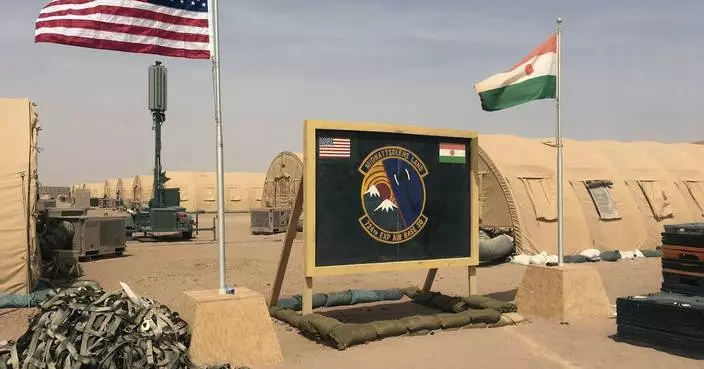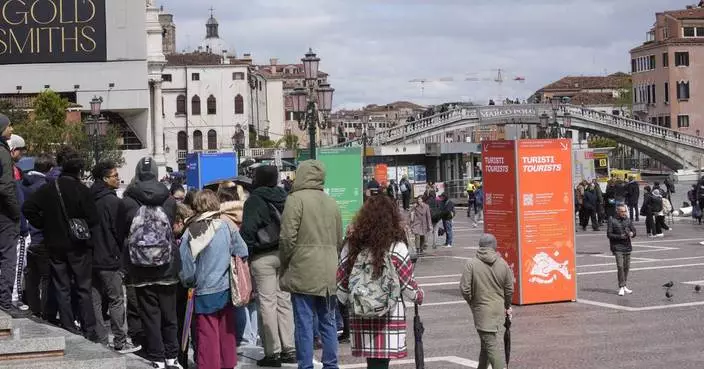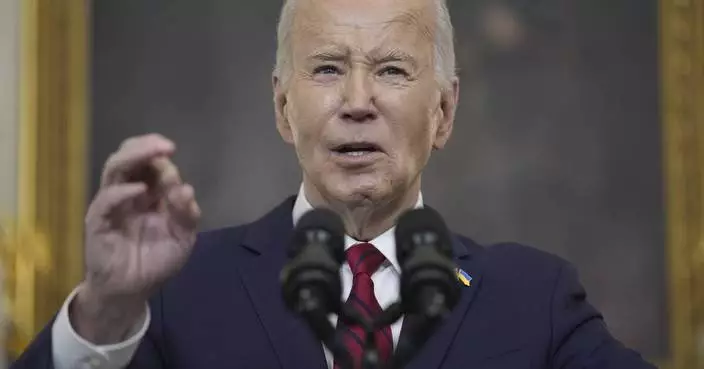The darkest, most violent chapter in the history of Bisbee was an open secret for decades in the funky old Arizona copper town 7 miles north of the U.S.-Mexico border.
But few residents knew the details of how about 1,200 miners, most of them immigrants, were pulled violently from their homes a century ago by a private police force and put on cattle cars for their deportation to a desolate area of New Mexico.
Click to Gallery
The darkest, most violent chapter in the history of Bisbee was an open secret for decades in the funky old Arizona copper town 7 miles north of the U.S.-Mexico border.
"Bisbee '17" will be nationally broadcast for the first time Monday night on the PBS documentary series POV. In Arizona, it will be shown at 9 p.m.
This undated photo provided by 4th Row Films shows striking miners being loaded in rail cars in "Bisbee '17," a story of how some 1,200 miners, most of them immigrants, were pulled violently from their homes in Bisbee, Ariz., by a private police force and put on cattle cars for deportation to a desolate area of New Mexico in 1917. The dark history of Bisbee was largely an open secret for decades in the funky old copper town just seven miles north of the U.S.-Mexico border. It's the sixth film of director Robert Greene, who said he learned about the town southeastern Arizona around 15 years ago. (Jarred Alterman4th Row Films via AP)
This undated photo provided by 4th Row Films shows Fernando Serrano, 23, who plays a striking miner in "Bisbee '17," a story of how some 1,200 miners, most of them immigrants, were pulled violently from their homes in Bisbee, Ariz., by a private police force and put on cattle cars for deportation to a desolate area of New Mexico in 1917. The dark history of Bisbee was largely an open secret for decades in the funky old copper town just seven miles north of the U.S.-Mexico border. It's the sixth film of director Robert Greene, who said he learned about the town southeastern Arizona around 15 years ago. (Jarred Alterman4th Row Films via AP)
This undated photo provided by 4th Row Films shows men in a planning meeting in "Bisbee '17," a story of how some 1,200 miners, most of them immigrants, were pulled violently from their homes in Bisbee, Ariz., by a private police force and put on cattle cars for deportation to a desolate area of New Mexico in 1917. The dark history of Bisbee was largely an open secret for decades in the funky old copper town just seven miles north of the U.S.-Mexico border. It's the sixth film of director Robert Greene, who said he learned about the town southeastern Arizona around 15 years ago. (Jarred Alterman4th Row Films via AP)
This May 23, 2019 photo shows modern-day Bisbee, Ariz., with itslarge open-pit copper mine in the background, the subject of "Bisbee '17," a story of how some 1,200 miners, most of them immigrants, were pulled violently from their homes in Bisbee by a private police force and put on cattle cars for deportation to a desolate area of New Mexico in 1917. The dark history of Bisbee was largely an open secret for decades in the funky old copper town just seven miles north of the U.S.-Mexico border. It's the sixth film of director Robert Greene, who said he learned about the town southeastern Arizona around 15 years ago. (AP PhotoAnita Snow)
FILE - This Feb. 17, 2013 file photo shows shops and restaurants on the main street in this once bustling mining town of Bisbee, Ariz. The town is the setting of "Bisbee '17," a story of how some 1,200 miners, most of them immigrants, were pulled violently from their homes in Bisbee by a private police force and put on cattle cars for deportation to a desolate area of New Mexico in 1917. The dark history of Bisbee was largely an open secret for decades in the funky old copper town just seven miles north of the U.S.-Mexico border. (AP PhotoRoss D. Franklin)
FILE - This May 12, 2019 file shows what's left of the Lavender pit mine outside the southeastern Arizona city of Bisbee, where the copper operation stopped in 1974.The mine and the town are the subject of "Bisbee '17," a story of how some 1,200 miners, most of them immigrants, were pulled violently from their homes in Bisbee by a private police force and put on cattle cars for deportation to a desolate area of New Mexico in 1917. The dark history of Bisbee was largely an open secret for decades in the funky old copper town just seven miles north of the U.S.-Mexico border. It's the sixth film of director Robert Greene, who said he learned about the town southeastern Arizona around 15 years ago. (AP PhotoAnita Snow)
The filming of "Bisbee '17," a documentary about what happened July 12, 1917, was a history lesson for residents recruited to play historical figures in the production that weds documentary and collective performance. It is, at turns, a Western, a musical and a ghost story.
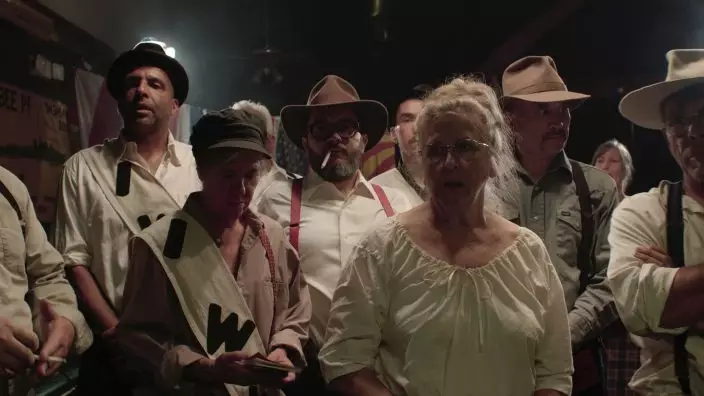
This undated photo provided by 4th Row Films shows a meeting of striking miners and union organizers in "Bisbee '17," a story of how some 1,200 miners, most of them immigrants, were pulled violently from their homes in Bisbee, Ariz., by a private police force and put on cattle cars for deportation to a desolate area of New Mexico in 1917. The dark history of Bisbee was largely an open secret for decades in the funky old copper town just seven miles north of the U.S.-Mexico border. It's the sixth film of director Robert Greene, who said he learned about the town southeastern Arizona around 15 years ago. (Jarred Alterman4th Row Films via AP)
"Bisbee '17" will be nationally broadcast for the first time Monday night on the PBS documentary series POV. In Arizona, it will be shown at 9 p.m.
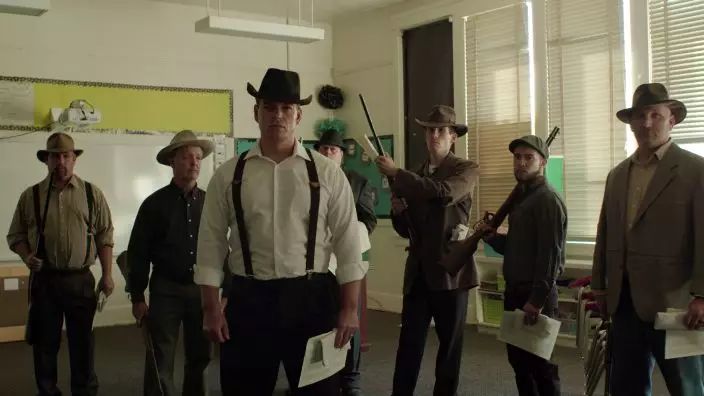
This undated photo provided by 4th Row Films, town residents dressed in period costume stand in a modern day classroom in "Bisbee '17," as they re-enact the deputizing of a private police force that broke up a brewing strike at a copper mine on July 12, 1917 when they rounded up some 1,200 miners, locked them into cattle cars and deported them over the state line into a barren part of southern New Mexico. The dark history of Bisbee was largely an open secret for decades in the funky old copper town just seven miles north of the U.S.-Mexico border. It's the sixth film of director Robert Greene, who said he learned about the town southeastern Arizona around 15 years ago. (Jarred Alterman4th Row Films via AP)
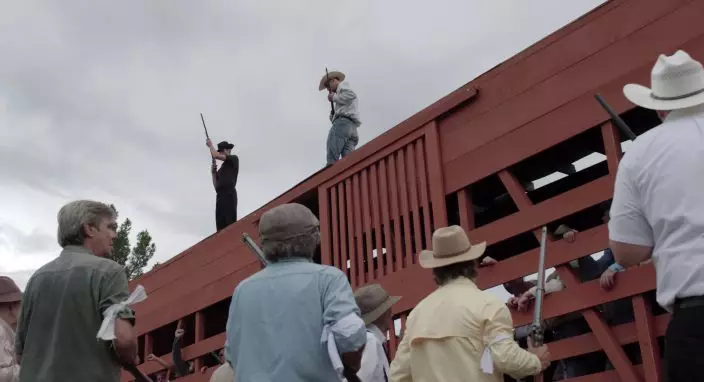
This undated photo provided by 4th Row Films shows striking miners being loaded in rail cars in "Bisbee '17," a story of how some 1,200 miners, most of them immigrants, were pulled violently from their homes in Bisbee, Ariz., by a private police force and put on cattle cars for deportation to a desolate area of New Mexico in 1917. The dark history of Bisbee was largely an open secret for decades in the funky old copper town just seven miles north of the U.S.-Mexico border. It's the sixth film of director Robert Greene, who said he learned about the town southeastern Arizona around 15 years ago. (Jarred Alterman4th Row Films via AP)
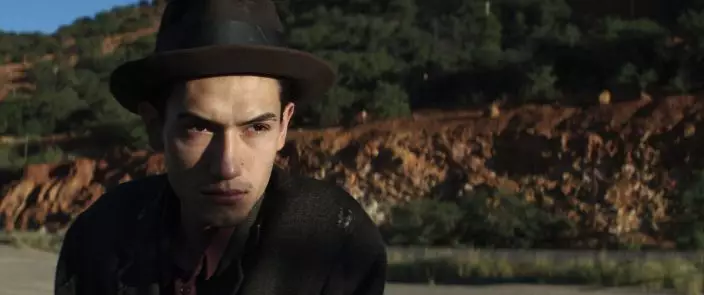
This undated photo provided by 4th Row Films shows Fernando Serrano, 23, who plays a striking miner in "Bisbee '17," a story of how some 1,200 miners, most of them immigrants, were pulled violently from their homes in Bisbee, Ariz., by a private police force and put on cattle cars for deportation to a desolate area of New Mexico in 1917. The dark history of Bisbee was largely an open secret for decades in the funky old copper town just seven miles north of the U.S.-Mexico border. It's the sixth film of director Robert Greene, who said he learned about the town southeastern Arizona around 15 years ago. (Jarred Alterman4th Row Films via AP)
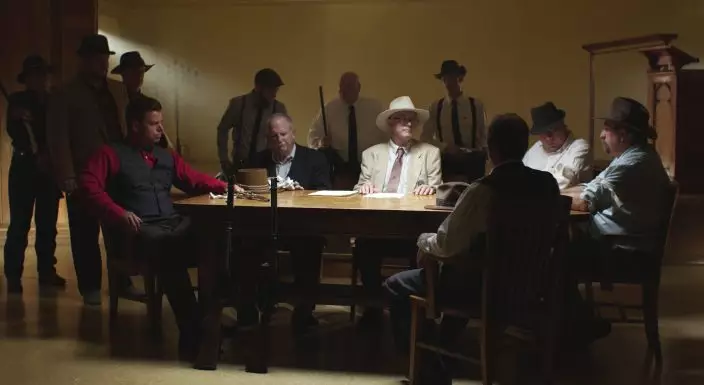
This undated photo provided by 4th Row Films shows men in a planning meeting in "Bisbee '17," a story of how some 1,200 miners, most of them immigrants, were pulled violently from their homes in Bisbee, Ariz., by a private police force and put on cattle cars for deportation to a desolate area of New Mexico in 1917. The dark history of Bisbee was largely an open secret for decades in the funky old copper town just seven miles north of the U.S.-Mexico border. It's the sixth film of director Robert Greene, who said he learned about the town southeastern Arizona around 15 years ago. (Jarred Alterman4th Row Films via AP)
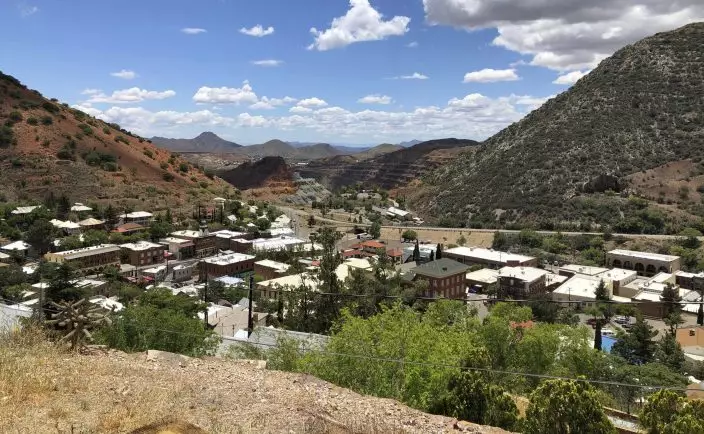
This May 23, 2019 photo shows modern-day Bisbee, Ariz., with itslarge open-pit copper mine in the background, the subject of "Bisbee '17," a story of how some 1,200 miners, most of them immigrants, were pulled violently from their homes in Bisbee by a private police force and put on cattle cars for deportation to a desolate area of New Mexico in 1917. The dark history of Bisbee was largely an open secret for decades in the funky old copper town just seven miles north of the U.S.-Mexico border. It's the sixth film of director Robert Greene, who said he learned about the town southeastern Arizona around 15 years ago. (AP PhotoAnita Snow)
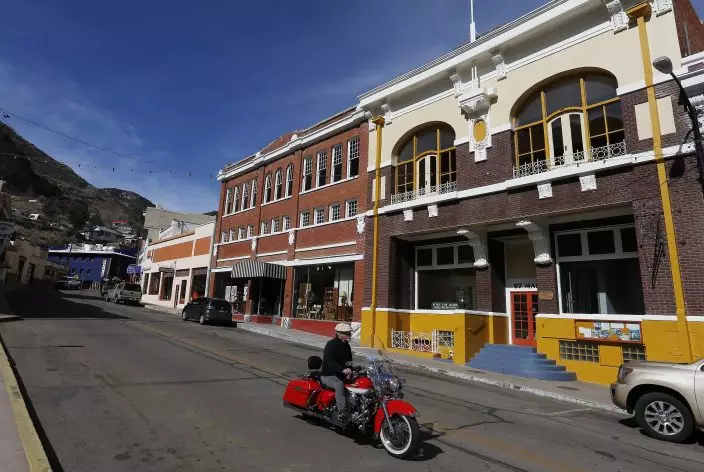
FILE - This Feb. 17, 2013 file photo shows shops and restaurants on the main street in this once bustling mining town of Bisbee, Ariz. The town is the setting of "Bisbee '17," a story of how some 1,200 miners, most of them immigrants, were pulled violently from their homes in Bisbee by a private police force and put on cattle cars for deportation to a desolate area of New Mexico in 1917. The dark history of Bisbee was largely an open secret for decades in the funky old copper town just seven miles north of the U.S.-Mexico border. (AP PhotoRoss D. Franklin)
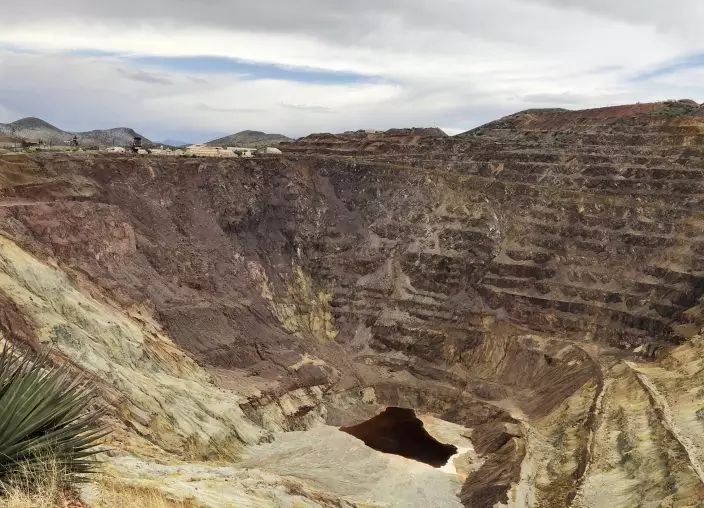
FILE - This May 12, 2019 file shows what's left of the Lavender pit mine outside the southeastern Arizona city of Bisbee, where the copper operation stopped in 1974.The mine and the town are the subject of "Bisbee '17," a story of how some 1,200 miners, most of them immigrants, were pulled violently from their homes in Bisbee by a private police force and put on cattle cars for deportation to a desolate area of New Mexico in 1917. The dark history of Bisbee was largely an open secret for decades in the funky old copper town just seven miles north of the U.S.-Mexico border. It's the sixth film of director Robert Greene, who said he learned about the town southeastern Arizona around 15 years ago. (AP PhotoAnita Snow)
KYIV, Ukraine (AP) — A Ukrainian court on Friday ordered the detention of the country’s farm minister in the latest high-profile corruption investigation, while Kyiv security officials assessed how they can recover lost battlefield momentum in the war against Russia.
Ukraine’s High Anti-Corruption Court ruled that Agriculture Minister Oleksandr Solskyi should be held in custody for 60 days, but he was released after paying bail of 75 million hryvnias ($1.77 million), a statement said.
Ukraine’s National Anti-Corruption Bureau suspects Solskyi headed an organized crime group that between 2017 and 2021 unlawfully obtained land worth 291 million hryvnias ($6.85 million) and attempted to obtain other land worth 190 million hryvnias ($4.47 million).
Ukraine is trying to root out corruption that has long dogged the country. A dragnet over the past two years has seen Ukraine’s defense minister, top prosecutor, intelligence chief and other senior officials lose their jobs.
That has caused embarrassment and unease as Ukraine receives tens of billions of dollars in foreign aid to help fight Russia’s army, and the European Union and NATO have demanded widespread anti-graft measures before Kyiv can realize its ambition of joining the blocs.
In Ukraine's capital, doctors and ambulance crews evacuated patients from a children’s hospital on Friday after a video circulated online saying Russia planned to attack it.
Parents hefting bags of clothes, toys and food carried toddlers and led young children from the Kyiv City Children’s Hospital No. 1 on the outskirts of the city. Medics helped them into a fleet of waiting ambulances to be transported to other facilities.
In the video, a security official from Russian ally Belarus alleged that military personnel were based in the hospital. Kyiv city authorities said that the claim was “a lie and provocation.”
Kyiv Mayor Vitali Klitschko said that civic authorities were awaiting an assessment from security services before deciding when it was safe to reopen the hospital.
“We cannot risk the lives of our children,” he said.
Meanwhile, Ukrainian President Volodymyr Zelenskyy was due to hold online talks Friday with the Ukraine Defense Contact Group, which has been the key international organization coordinating the delivery of weapons and other aid to Ukraine.
Zelenskyy said late Thursday that the meeting would discuss how to turn around Ukraine’s fortunes on the battlefield. The Kremlin’s forces have gained an edge over Kyiv’s army in recent months as Ukraine grappled with a shortage of ammunition and troops.
Russia, despite sustaining high losses, has been taking control of small settlements as part of its effort to drive deeper into eastern Ukraine after capturing the city of Avdiivka in February, the U.K. defense ministry said Friday.
It’s been slow going for the Kremlin’s troops in eastern Ukraine and is likely to stay that way, according to the Institute for the Study of War. However, the key hilltop town of Chasiv Yar is vulnerable to the Russian onslaught, which is using glide bombs — powerful Soviet-era weapons that were originally unguided but have been retrofitted with a navigational targeting system — that obliterate targets.
“Russian forces do pose a credible threat of seizing Chasiv Yar, although they may not be able to do so rapidly,” the Washington-based think tank said late Thursday.
It added that Russian commanders are likely seeking to advance as much as possible before the arrival in the coming weeks and months of new U.S. military aid, which was held up for six months by political differences in Congress.
While that U.S. help wasn’t forthcoming, Ukraine’s European partners didn’t pick up the slack, according to German’s Kiel Institute for the World Economy, which tracks Ukraine support.
“The European aid in recent months is nowhere near enough to fill the gap left by the lack of U.S. assistance, particularly in the area of ammunition and artillery shells,” it said in a report Thursday.
Ukraine is making a broad effort to take back the initiative in the war after more than two years of fighting. It plans to manufacture more of its own weapons in the future, and is clamping down on young people avoiding conscription, though it will take time to process and train any new recruits.
Jill Lawless contributed to this report.
Follow AP’s coverage of the war in Ukraine at https://apnews.com/hub/russia-ukraine
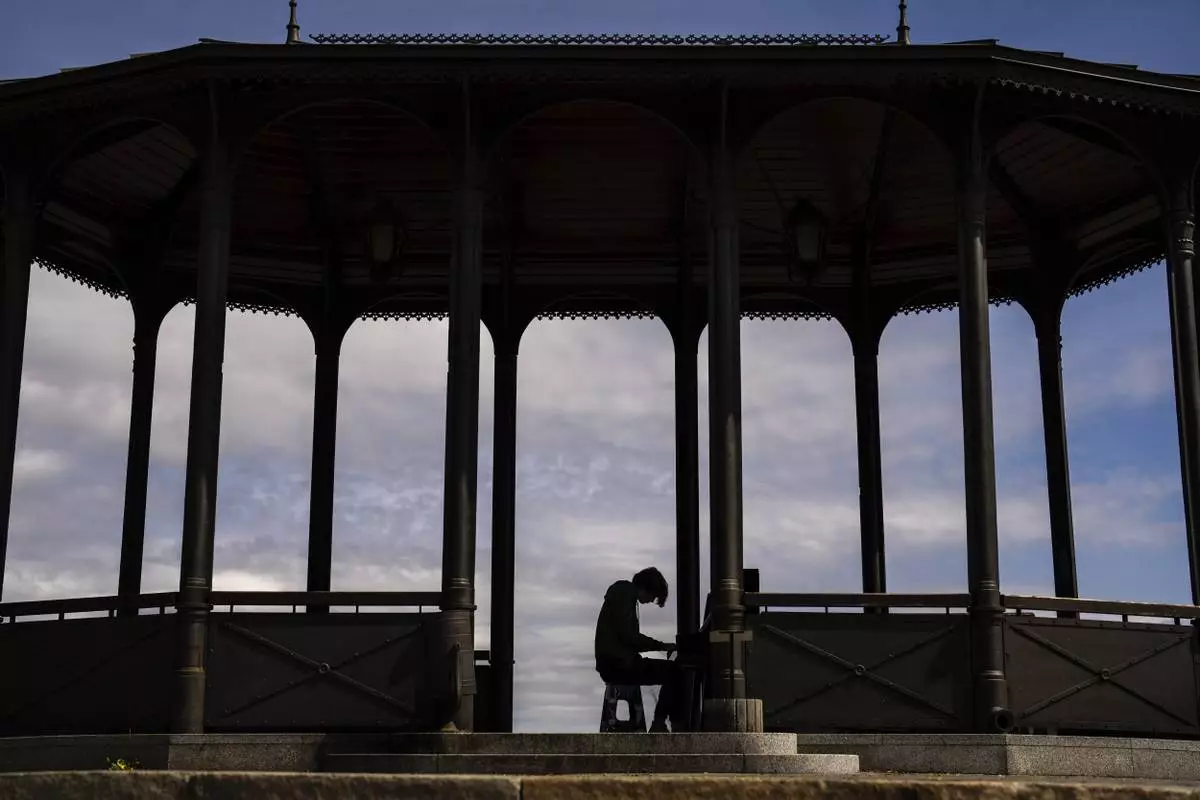
Ukrainian young acting student Gleb Batonskiy plays piano in a public park in Kyiv, Ukraine, Thursday, April 25, 2024. (AP Photo/Francisco Seco)














